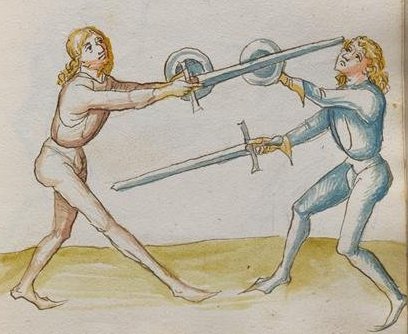Volta Stabile
The stable, or fixed point turn changes the orientation of the sword's edge from inside to outside, or false to true, without moving the point significantly. It is easy to think of this in terms of rapier guards. Changing from guard to guard involves a stable turn: the hand moves, say from palm up to palm down when switching from quarta to seconda, but the point stays on line. With a longsword the hands may move farther and the wrists may cross when switching from a low to a high or an outside to an inside guard, but if the point stays on line it is a volta stabile.
This turn is used to change the line on which you are defending your body, to change a cut into a thrust, (eg, to change from a fendente to an imbrocatta), or to reach around the opponent's sword in a punta dritta or punta roversa.
Practise your stable turns by placing your point gently on your partner's open hand, or on a wall. Change through your guard positions, from high inside, through the stretta guards to high outside, and back again, keeping the point in one place.
Mezza Volta
In the half turn, the point of the sword travels in semi-circular arc from one line to another. Although the point makes a half-circle, the blade ends up about a quarter of the way along the cutting circle. For example if your sword moves from inside to outside on the high line (roverso to mandritto squalembratti) this would be a half turn. Another half turn is a cut that moves from a high to low guard on the same side of the body.
These turns often occur when the sword is parried but can also be used as feints, or to change the line of attack in response to your opponent's movement. However for the Green Spur we are not looking for this level of sophisticated response. The ability to demonstrate a simple mezza volta of the sword is enough.
Tutta Volta
The full turn takes the point of the sword in a complete circle. A stramazzone (a wrist cut that makes a full circle) is an example of a tutta volta. So too is an elbow cut that starts in a low outside guard and delivers a roverso squalembratto to the opponent's left shoulder. In order to make that cut you need your sword point to travel in a circle behind you and across to the other side of the body.
Tutte Volte generally travel along the diagonal cutting paths from low to high, inside to outside, and vice versa, and are good preparations for powerful cuts.
Next week: Anatomy of the Sword.
o o o
This week we are enjoying the all-you-can-eat swordplay buffet that is VISS, so there will be no Open Barn. If you still haven't signed up and are wondering which workshops would best further your Mounted Combat skills, I suggest any of the longsword or sidesword workshops, in particular day 3 of the Fiore Armizare. If you have a penchant for more modern mounted combat there's a Sabre workshop on day to scratch that itch. I'll be indulging in these last two plus a whole lot of rapier, and I hope to cross swords with many of you there.
Cavaliere Classes resume on February 24th. It was a gorgeous day on Sunday and the ring was firm enough for jumping, so it should be even better in a couple of weeks!
Jennifer Landels, Maestra di Scuderia
Academie Duello Cavaliere Program
Comment on this post on our Posterous Blog.
